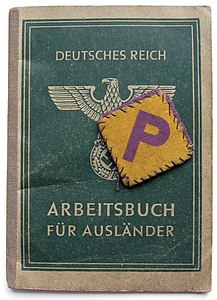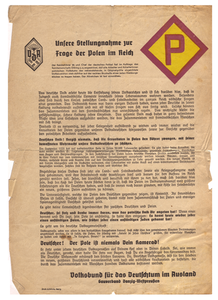
The "P" symbol [1] or "P" badge [2] was introduced on 8 March 1940 by the Nazi Germany General Government in relation to the requirement that Polish workers ( Zivilarbeiter) used during World War II as forced laborers in Germany (following the German invasion and occupation of Poland in 1939) display a visible symbol marking their ethnic origin. The symbol was introduced with the intent to be used as a cloth patch, which indeed was the most common form, but also reproduced on documents (through stamps) and posters. The badge was intended to be humiliating, [2] [3] and like the similar Jewish symbol, can be seen as a badge of shame. [4]
Design and usage
The design was introduced in the Polish decrees (laws concerning Polish workers in Germany) on 8 March 1940. [2] The symbol was a diamond with sides of five centimeters. The border (about half a centimetre wide) and the letter P (two and a half centimetres tall) were violet, while the inside of the symbol was yellow. [5] [3] The letter "P" badge was to be worn on the right breast of every garment worn. Those who did not obey the rules were subject to a fine of up to 150 Reichsmarks and arrested with a possible penalty of six weeks' detention.[ citation needed]
The choice of color and shape might have been chosen to avoid any association with the national symbols of Poland. [3] It was the first official, public badge-like mark intended for identification of individuals based on their racial or ethnic origin (or other social characteristics) introduced in Nazi Germany, preceding the better-known " Jewish yellow star" badge introduced a year later, in September 1941. [2]
In January 1945 the Central Office for Reich Security proposed a new design for a Polish badge, a yellow ear of corn on a red and white label, but it was never implemented. [3]
Examples of usage
-
Arbeitsbuch Für Ausländer (Workbook for Foreigners) identity document issued to a Polish Forced Labourer in 1942 together with a letter "P" patch that Poles were required to wear attached to their clothing
-
Anti-Polish poster published by Volksbund für das Deutschtum im Ausland (Association for 'Germanness' abroad) Gauverband Danzig Westpreußen (Association of the "shire or county", Gdansk, West Prussia)
See also
References
- ^ Friedlander, Henry; Milton, Sybil (1989). Archives of the Holocaust: an international collection of selected documents. Garland. p. 725. ISBN 978-0-8240-5483-0.
- ^ a b c d Ulrich Herbert (1997). Hitler's Foreign Workers: Enforced Foreign Labor in Germany Under the Third Reich. Cambridge University Press. pp. 8, 72, 321. ISBN 978-0-521-47000-1.
- ^ a b c d "The letter "P"". Porta Polonica. Retrieved 30 June 2015.
-
^ D'Ancona, Jacob (2003). The City Of Light. New York: Citadel. pp. 23–24.
ISBN
0-8065-2463-4.
But the wearing of a badge or outward sign — whose effect, intended or otherwise, successful or not, was to shame and to make vulnerable as well as to distinguish the wearer…
- ^ Studia ślas̨kie (in Polish). 1966. p. 282.
Further reading
- Bartosz, Julian (1969). Ludzie ze znakiem P. (in Polish). ZakŁad Narodowy im: Ossolińskich.
- Koziełło-Poklewski, Bohdan; Łukaszewicz, Bohdan; Badań Naukowych im. Wojciecha Kętrzyńskiego w Olsztynie, Ośrodek (1985). Ze znakiem "P": relacje i wspomnienia z robót przymusowych w Prusach Wschodnich w latach 2 wojny światowej (in Polish). Ośrodek Badań Naukowych im. Wojciecha Kętrzyńskiego.

